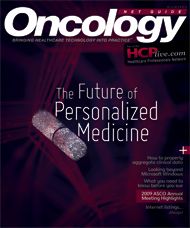Publication
Article
Oncology Live®
5 questions with Yue Xiong
Author(s):
The beat on the people, devices, trends, and companies shaping healthcare... with Yue Xiong, PhD, Professor of Biochemistry and Biophysics, UNC Lineberger Comprehensive Cancer Center.
In the April 10, 2009 issue of Science, Dr Xiong and colleagues published their promising findings regarding secondary glioblastoma multiforme (GBM), one of the most deadly cancers. According to the authors, 75% of low grade gliomas and secondary GBMs have mutations in the isocitrate dehydrogenase-1 (IDH1) gene, resulting in a reduced level of a compound called α-ketoglutarate (α-KG). Low levels of α-KG promote tumor growth in part because of induced HIF-1α pathway that leads to increased nutrient and oxygen supplies to the tumor. Dr Xiong and colleagues discovered that when an α-KG analog is added to the tumor cells, these effects caused by the mutant IDH1 gene are reversed.
1) How did you and your team discover the α-KG compound?
Was it one of many compounds tested? The α-KG analog has been described in the literature, and after chemical modification, α-KG can enter the cells. The discovery that tumor- derived mutations in IDH1
gene reduce the catalytic activity and the level of α-KG led us to test whether adding the α-KG analog back to the cultured cells would reverse the effect caused by the mutant IDH1. Although several α-KG analogs are reported in the literature, we have only tested one thus far.
2) Can you tell us a little bit about the effects you observed when α-KG was added to tumor cells?
We’ve only tested the effect of α-KG analog in cultured tumor cells, not yet in primary tumors. The test was relatively straightforward: tumor-derived mutations in IDH1 reduced the catalytic activity of IDH1 enzymes, resulting in a decrease of its product, α-KG. A decreased α-KG is known to cause stabilization, resulting in an accumulation of HIF-1α, which is a transcription factor that regulates many genes involved in nutrient and oxygen supplies. We used the level of HIF-1α as the test and found that the α-KG analog can reverse the accumulation of HIF-1α caused by the expression of the IDH1 mutant.
3) Are you working on developing a mouse model to test α-KG as a treatment for secondary GBMs, and, if so, when do you anticipate being able to start conducting this study?
Also, should such studies go well, how long do you think it would be before such treatments become available to patients with secondary GBMs? We are currently working on developing a mouse model based on this discovery, and one of the major goals of developing this model is to test α-KG analog as a treatment for low grade gliomas and secondary GBMs. If things move well, we anticipate having the mouse model in less than 2 years, and the subsequent test of the α-KG analog would take about a year. In the meantime, we are in discussions with clinical doctors and experts from medicinal chemistry on how to move this finding to the bedside more quickly for patients.
4) Based on your preliminary results, what effect on survival do you think α-KG may have for secondary GBM patients with the IDH1 mutation?
It’s difficult to predict. Given the highly restricted spectrum of the IDH1 gene mutation (only found in low grade glioma and secondary GBM, not in many other types of tumors examined), there is a reason to expect a strong effect if we can develop an α-KG drug and figure out a way of deliver it to the right place in patients.
5) Your study was conducted in collaboration with researchers and students at Fudan University in Shanghai, China. Were there any challenges and/ or benefits in working with a team located so far away?
The actual experiments were carried out in Fudan University, and such a long distance did pose some new challenges to me and my colleague, Dr. Kun-Liang Guan from UCSD. Fortunately, both the junior faculty and graduate students who worked with
us are highly motivated and skillful. One unique aspect of this study is the terrific collaboration among the faculty with different expertise, including biochemistry, cell biology, protein structure, and tumor biology.
Find out more about what Yue Xong, PhD, and his team are doing.









